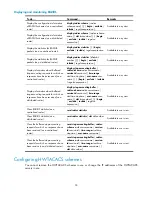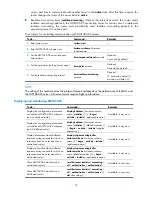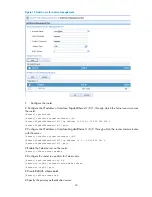
45
To do…
Command…
Remarks
8.
Specify the authorization
method for portal users.
authorization portal
{
local
|
none
|
radius-scheme
radius-scheme-name
[
local
] }
Optional.
The default authorization
method is used by default.
9.
Specify the authorization
method for PPP users.
authorization ppp
{
hwtacacs-scheme
hwtacacs-scheme-name
[
local
] |
local
|
none
|
radius-scheme
radius-scheme-name
[
local
] }
Optional.
The default authorization
method is used by default.
10.
Specify the authorization
method for SSL VPN
users.
authorization ssl-vpn radius-scheme
radius-
scheme-name
Optional.
The default authorization
method is used by default.
NOTE:
•
The authorization method specified with
authorization default
is for all types of users and has a
lower priority than that for a specific access type.
•
If you configure an authentication method and an authorization method that use RADIUS schemes for
an ISP domain, the RADIUS scheme for authorization must be the same as that for authentication. If
the RADIUS authorization configuration is invalid or RADIUS authorization fails, the RADIUS
authentication also fails. Whenever RADIUS authorization fails, an error message is sent to the NAS,
indicating that the server is not responding.
•
If you specify the
radius-scheme
radius-scheme-name
local
or
hwtacacs-scheme
hwtacacs-scheme-
name [
local
|
none
] keyword and argument combination when configuring an authorization
method, local authorization or no authorization is the backup method and is used only when the
remote server is not available.
•
If you specify only the
local
or
none
keyword in an authorization method configuration command,
the router has no backup authorization method. It performs only local authorization or does not
perform any authorization.
Configuring AAA accounting methods for an ISP domain
In AAA, accounting is a separate process at the same level as authentication and authorization. Its
responsibility is to send accounting start/update/end requests to the specified accounting server.
Accounting is not required, and accounting method configuration is optional.
AAA supports the following accounting methods:
•
No accounting (
none
)—The system does not perform accounting for the users.
•
Local accounting (
local
)—Local accounting is implemented on the router. It is for counting and
controlling the number of concurrent users who use the same local user account; it does not provide
statistics for charging. The maximum number of concurrent users using the same local user account
is set by
access-limit
in local user view.
•
Remote accounting (
scheme
)—The router cooperates with a RADIUS server or HWTACACS server
for accounting of users. Configure local accounting or no accounting as the backup method to be
used when the remote server is not available.
By default, an ISP domain uses the local accounting method.
Before configuring accounting methods, complete the following tasks:
1.
For RADIUS or HWTACACS accounting, configure the RADIUS or HWTACACS scheme to be
referenced first. The
local
and
none
authentication methods do not require any scheme.
















































